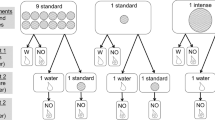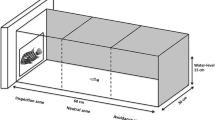Abstract
Recent studies have shown that prey living under conditions of elevated predation risk respond very differently to novel predators than prey living under low-risk conditions, by displaying generalized avoidance patterns to novel stimuli. This phenotypic plasticity in neophobic responses provides prey with the means to respond flexibly to uncertain risks, but we know almost nothing about how long neophobic responses are maintained. Using extinction testing, we demonstrate that neophobic responses of guppies (Poecilia reticulata) to a novel odour waned relatively quickly over five consecutive exposures, but the waning of responses to one stimulus does not affect neophobic responses to other novel odours. In a subsequent experiment, we demonstrate that learned responses to predator cues in fish from high- and low-risk populations both waned over time, but fish from the high-risk population retained the response longer than those from the low-risk population. Background levels of predation risk appear to be crucial factors in driving differences in retention of risk-related information.


Similar content being viewed by others
References
Acquistapace P, Hazlett BA, Gherardi F (2003) Unsuccessful predation and learning of predator cues by crayfish. J Crustacean Biol 23:364–370
Allen MT, Cheius L, Masand V, Gluck MS, Myers EE, Schnirman G (2002) A comparison of latent inhibition and learned irrelevance pre-exposure effects in rabbit and human eye blink conditioning. Integr Physiol Behav Sci 37:188–214
Botham MS, Hayward RK, Morrell LJ, Croft DP, Ward JR, Ramnarine I, Krause J (2008) Risk-sensitive antipredator behaviour in the Trinidadian guppy, Poecilia reticulata. Ecology 89:3174–3185
Brönmark C, Pettersson LB (1994) Chemical cues from piscivores induce a change in morphology in Crucian carp. Oikos 70:396–402
Brown C, Braithwaite VA (2005) Effects of predation pressure on the cognitive ability of the poeciliid Brachyraphis episcopi. Behav Ecol 16:482–487
Brown C, Warburton K (1999) Differences in timidity and escape responses between predator-naïve and predator-sympatric rainbow fish populations. Ethology 105:491–502
Brown C, Jones F, Braithwaite V (2005) In situ examination of boldness-shyness traits in the tropical poeciliid, Brachyraphis episcopi. Anim Behav 70:1003–1009
Brown GE, Macnaughton CJ, Elvidge CK, Ramnarine I, Godin J-GJ (2009) Provenance and threat-sensitive predator avoidance patterns in wild-caught Trinidadian guppies. Behav Ecol Sociobiol 63:699–706
Brown GE, Elvidge CK, Macnaughton CJ, Ramnarine I, Godin J-GJ (2010) Cross-population responses to conspecific chemical alarm cues in wild Trinidadian guppies, Poecilia reticulata: evidence for local conservation of cue production. Can J Zool 88:139–147
Brown GE, Ferrari MCO, Chivers DP (2011a) Learning about danger: chemical alarm cues and threat-sensitive assessment of predation risk by fishes. In: Brown C, Laland K, Krause J (eds) Fish cognition and behaviour, 2nd edn. Wiley-Blackwell, West Sussex, UK, pp 59–80
Brown GE, Ferrari MCO, Malka PH, Russo S, Tressider M, Chivers DP (2011b) Generalization of predators and nonpredators by juvenile rainbow trout: learning what is and is not a threat. Anim Behav 81:1249–1256
Brown GE, Ferrari MCO, Elvidge CK, Ramnarine I, Chivers DP (2013) Phenotypically plastic neophobia: a response to variable predation risk. Proc R Soc Lond B 280:20122712
Brown GE, Elvidge CK, Ramnarine I, Chivers DP, Ferrari MCO (2014a) Personality and the response to predation risk: effects of information quantity and quality. Anim Cogn 17:1063–1069
Brown GE, Ferrari MCO, Elvidge CK, Jackson CD, Chivers DP (2014b) Background level of risk determines the intensity of predator neophobia in cichlids. Behav Ecol Sociobiol 68:127–133
Chivers DP, Smith RJF (1998) Chemical alarm signaling in aquatic predator-prey systems: a review and prospectus. Écoscience 5:338–352
Chivers DP, Brown GE, Ferrari MCO (2012) The evolution of alarm substances and disturbance cues in aquatic animals. In: Brönmark C, Hansson L-A (eds) Chemical ecology in aquatic systems. Oxford University Press, Oxford, pp 127–139
Chivers DP, McCormick MI, Mitchell MD, Ramasamy RA, Ferrari MCO (2014) Background level of risk determines how prey categorize predators and non-predators. Proc R Soc Lond B 281:20140355
Croft DP, Botham MS, Krause J (2004) Is sexual segregation in the guppy, Poecilia reticulata, consistent with the predation risk hypothesis. Environ Biol Fish 71:127–133
Croft DP, Morrell LJ, Wade AS, Piyapong C, Ioannou CC, Dyer JRG, Chapman BB, Wong Y, Krause J (2006) Predation risk as a driving force for sexual segregation: a cross-population comparison. Am Nat 167:867–878
Dall SRX, Johnstone RA (2002) Managing uncertainty: information and insurance under the risk of starvation. Philos T Roy Soc B 357:1519–1526
Davis DR, Epp KJ, Gabor CR (2012) Predator generalization decreases the effect of introduced predators in the San Marcos salamander, Eurycea nana. Ethology 118:1191–1197
Eiben B, Persons M (2007) The effect of prior exposure to predator cues on chemically-mediated defensive behavior and survival in the wolf spider Rabidosa rabida (Araneae: Lycosidae). Behavior 144:889–906
Endler J, Houde AE (1995) Geographic variation in female preferences for male traits in Poecilia reticulata. Evolution 49:456–468
Ferrari MCO (2014) Short-term environmental variation in predation risk leads to differential performance in predation-related cognitive function. Anim Behav 95:9–14
Ferrari MCO, Trowell JJ, Brown GE, Chivers DP (2005) The role of learning in the development of threat-sensitive predator avoidance by fathead minnows. Anim Behav 70:777–784
Ferrari MCO, Gonzalo A, Messier F, Chivers DP (2007) Generalization of learned predator recognition: an experimental test and framework for future studies. Proc R Soc Lond B 274:1853–1859
Ferrari MCO, Sih A, Chivers DP (2009) The paradox of risk allocation: a review and prospectus. Anim Behav 78:579–585
Ferrari MCO, Brown GE, Bortolotti GR, Chivers DP (2010a) Linking predator risk and uncertainty to adaptive forgetting: a theoretical framework and empirical test using tadpoles. Proc R Soc Lond B 277:2205–2210
Ferrari MCO, Wisenden BD, Chivers DP (2010b) Chemical ecology of predator-prey interactions in aquatic ecosystems: a review and prospectus. Can J Zool 88:698–724
Gonzalo A, López P, Martin J (2010) Risk level of chemical cues determines retention of recognition of new predators in Iberian green frog tadpoles. Behav Ecol Sociobiol 64:1117–1123
Gonzalo A, López P, Martin J (2013) Adaptive forgetting in Iberian green frog tadpoles (Pelophylax perezi): learned irrelevance and latent inhibition may avoid predator misidentification. J Comp Psychol 127:56–62
Greenberg R, Mettke-Hofmann C (2001) Ecological aspects of neophobia and neophilia in birds. In: Nolan V Jr, Thompson CF (eds) Current ornithology, vol 16. Plenum Press, New York, pp 119–178
Griffin AS, Evans CS, Blumstein DT (2001) Learning specificity in acquired predator recognition. Anim Behav 62:577–589
Hirvonen H, Ranta E, Rita H, Peuhkuri N (1999) Significance of memory properties in prey choice decisions. Ecol Model 115:177–189
Huntingford FA, Coulter RM (1989) Habituation of predator inspection in the three-spined stickleback, Gasterosteus aculeatusL. J Fish Biol 35:153–154
Kats LB, Dill LM (1998) The scent of death: chemosensory assessment of predation risk by prey animals. Écoscience 5:361–394
Kelley JL, Magurran AE (2003) Effects of relaxed predation pressure on visual predator recognition in the guppy. Behav Ecol Sociobiol 54:225–232
Kelly CD, Godin J-GJ (2001) Predation risk reduces male-male sexual competition in the Trinidadian guppy (Poecilia reticulata). Behav Ecol Sociobiol 51:95–100
Kelly CD, Godin J-GJ, Wright JM (1999) Geographical variation in multiple paternity within natural populations of the guppy (Poecilia reticulata). Proc R Soc Lond B 266:2403–2408
Krause J (1993) The effect of ‘Schreskstoff’ on the shoaling behaviour of the minnow: a test of Hamilton’s selfish herd theory. Anim Behav 45:1019–1024
Lima SL, Bednekoff PA (1999) Temporal variation in danger drives antipredator behavior: The predation risk allocation hypothesis. Am Nat 153:649–659
Magurran AE (2005) Evolutionary ecology: the Trinidadian guppy. Oxford Series in Ecology and Evolution. Oxford University Press, Oxford
Mangel M (1990) Dynamic information in uncertain and changing worlds. J Theor Biol 146:317–332
Mathis A, Smith RJF (1993) Fathead minnows, Pimephales promelas, learn to recognize northern pike, Esox lucius, as predators on the basis of chemical stimuli from minnows in the pike's diet. Anim Behav 46:645–656
McNamara JM, Houston AI (1987) Memory and the efficient use of information. J Theor Biol 125:385–395
Mettke-Hoffman C, Winkler H, Hamel PB, Greenberg R (2013) Migratory new world blackbirds (Icterids) are more neophobic than closely related resident Icterids. PLoS One 8:e57565
Mitchell MD, McCormick MI, Ferrari MCO, Chivers DP (2011) Friend or foe? The role of latent inhibition in predator and non-predator labelling by coral reef fishes. Anim Cogn 14:707–714
Rankin CH, Abrams T, Barry RJ et al (2009) Habituation revisited: an updated and revised description of the behavioural characteristics of habituation. Neurobiol Learn Mem 92:135–138
Reznick D, Butler MJ IV, Rodd H (2001) Life-history evolution in guppies. VII. The comparative ecology of high- and low-predation environments. Am Nat 157:126–140
Shettleworth SJ (2001) Animal cognition and animal behaviour. Anim Behav 61:277–286
Sih A, Ziemba R, Harding KC (2000) New insights on how temporal variation in predation risk shapes prey behavior. Trends Ecol Evol 15:3–4
Sparks JS, Smith WL (2004) Phylogeny and biogeography of cichlid fishes (Teleostei: Perciformes: Cichlidae). Cladistics 20:501–517
Stankowich T, Blumstein DT (2005) Fear in animals: a meta-analysis and review of risk assessment. Proc R Soc Lond B 272:2627–2634
Stephens DW (1987) On economically tracking a variable environment. Theor Popul Biol 32:15–25
van Oosterhout C, Joyce DA, Cummings SM, Blais J, Barson NJ, Ramnarine IW, Mohammed RS, Persad N, Cable J (2006) Balancing selection, random genetic drift, and genetic variation at the major histocompatibility complex in two wild populations of guppies (Poecilia reticulata). Evolution 60:2562–2574
Vences M, Freyhof J, Sonneberg R, Kousch J, Veith M (2001) Reconciling fossils and molecules: Cenozoic divergence of cichlid fishes and the biogeography of Madagascar. J Biogeogr 28:1091–1099
Wisenden BD, Klitzke J, Nelson R, Friedl D, Jacobson PC (2004) Predator-recognition training of hatchery-reared walleye (Stizostedion vitreum) and a field test of a training method using yellow perch (Perca flavescens). Can J Fish Aquat Sci 61:2144–2150
Acknowledgments
We thank Heather Auld, Jean-Guy Godin and Pierre Chuard for assistance in field and the Director of Fisheries, Trinidad and Tobago Ministry of Agriculture, Land and Marine Resources for permission to collect and transport guppies. All work reported herein was conducted in accordance with Concordia University AREC-2011-BROW. Financial assistance was provided by the Natural Science and Engineering Research Council of Canada and Concordia University to GEB and Fond de recherché du Québec—Nature et technologiesto CKE.
Ethical standards
All work reported herein was conducted in accordance with Concordia University Animal Research Ethics protocol #AREC-2011-BROW and AREC-2012-BROW and complies with all provincial and federal legislation.
Author information
Authors and Affiliations
Corresponding author
Additional information
Communicated by J. Frommen
Rights and permissions
About this article
Cite this article
Brown, G.E., Elvidge, C.K., Ramnarine, I. et al. Background risk and recent experience influences retention of neophobic responses to predators. Behav Ecol Sociobiol 69, 737–745 (2015). https://doi.org/10.1007/s00265-015-1888-y
Received:
Revised:
Accepted:
Published:
Issue Date:
DOI: https://doi.org/10.1007/s00265-015-1888-y




